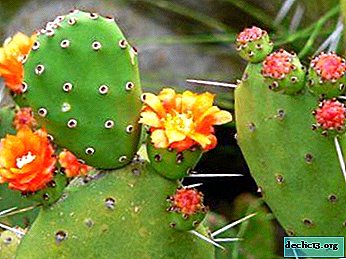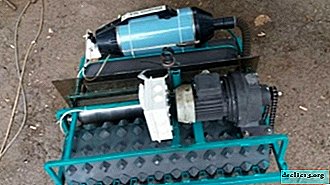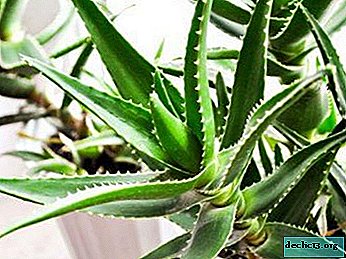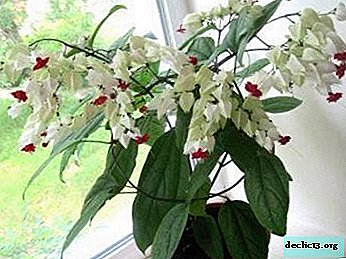Unpretentious romance: how to grow Midsammer roses?

The stereotype that roses are capricious in content completely disappears when working with the Midsammer variety.
It is not only frost-resistant, but also incredibly effective variety. Features of the Midsammer rose garden content are covered in our article. In it, we will talk about how the Midsammer rose differs from other varieties and how it is used in landscape design.
Also from this article you will learn about how to care for this flower and in what ways you can propagate it.
Description and photo
Rosa Midsammer belongs to the floribund family. The stalk is straight, up to one meter high. In width, the bush reaches 70 centimeters. The leaves are shiny, with a "waxy" coating, a dark, dense green hue. The buds are tight, pink or brown. Flowers are medium in size. Maximum diameter up to 80 mm. Red-pink, strawberry saturated color.
On the wrong side, the petals are yellowish-orange. Peduncles are strong. Thick double flowering. On one peduncle there are from ten to fifteen flowers. At the same time, buds bloom at different times, that is, on one bush there may be blooming and newly tied buds.
pros:
- Hardy disease resistant variety.
- Long and magnificent flowering.
- Compact size.
- Compared to other floribundas, this rose smells brighter than anyone.
Minuses:
- Not as pronounced aroma as in other varieties.
- Too "full" flowering. Not always the neighborhood of fading and blooming roses looks profitable and beautiful.
Below, in the photo, you will see how beautiful this flower is:




History of occurrence
The first floribund varieties appeared in the early twentieth century in the process of crossing tea and polyanthus roses. And here Midsummer was bred by Tantau in 2007 in Germany.
What is the difference from other types of roses?
First of all, aroma: delicate, light, but at the same time enchanting. Other floribundas cannot boast of any distinct aroma.
Bloom
When and how?
The name of its rose speaks about the flowering features of this rose, which means “mid-summer” in English. The flowering period falls from the end of June to October. Flowering in inflorescences, lush, dense.
Care before and after flowering
Features of care before and after flowering are the difference in fertilizing. Until the rose is watered with sodium humate at the rate of 1 tablespoon per 40 liters of water. In early spring, when the weather had not settled down, they sprayed with one vial of Epinoma diluted in 5 liters of water. After Midsammer bloomed for the first time, mineral fertilizers and nitrogen are introduced.
What if there are no buds?
This can happen for a number of reasons:
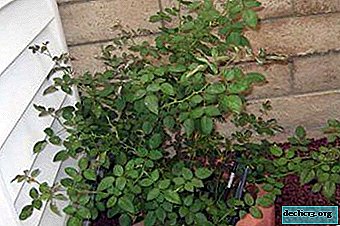 Poor planting material. In this case, nothing can be done with the existing plant, but for the future it is worth taking shoots only in trusted nurseries.
Poor planting material. In this case, nothing can be done with the existing plant, but for the future it is worth taking shoots only in trusted nurseries.- Bad soil. In this case, you need to bring the soil to the appropriate parameters or transplant the plant. Read more about both in the article.
- Incorrect feeding. About how and when to feed a rose, also read on.
- Lack of sunlight due to improper landing. The correct solution is to transplant the plant.
Use in landscape design
It is most beneficial to use the Midsammer rose for decorating facades. Its active, saturated color can interrupt other flowers, therefore it is better to use either one or combining it with another floribunda, Hot Chocolate variety. For the decoration of fences, hedges, this variety is not suitable, since its climbing variety does not exist.
Step-by-step care instructions
Site selection
This rose prefers open bright spaces protected from draft. In intense heat, it is worth scattering the sun's rays, as they can leave burns on the leaves.
What should be the soil?
Soil pick up a neutral pH level. The substrate should not be as heavy as black soil, but not as light as sand.
For the Midsammer floribunda, sandy soil should be diluted with chernozem, while clay soil should be diluted with sand. When planting, it is good to introduce peat, humus and superphosphate into the ground.
Seed planting
You can propagate this rose in a seed way. Seeds can be bought in the store, or you can collect them yourself. For this :
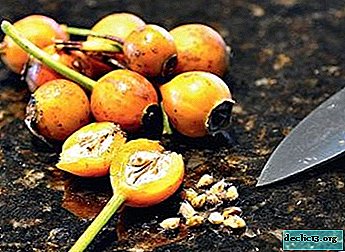 After a box with seeds is formed and ripens (after flowering), carefully open it and collect the seeds.
After a box with seeds is formed and ripens (after flowering), carefully open it and collect the seeds.- Rinse and disinfect the seeds in a solution of hydrogen peroxide for half an hour.
- Send the seeds into a glass of water for a day. Those seeds that will be drowned should be taken for further work in a day.
- Store seeds until next spring in the refrigerator or basement. You can sprinkle them with sand.
- At the end of winter, beginning of spring, subject the seeds to stratification, i.e. for 1.5-2 months, keep at a temperature of 2-4 degrees (in the refrigerator) in the wet state. To do this, wrap in a moist cotton pad.
- As soon as the shoots make their way - immediately plant them in the ground. Use small peat pots. Do not crush the seeds, slightly deepen.
- Cover with cling film and place in a warm place until the first shoots.
- As soon as the shoots appear, remove the film. The place should be bright, but without direct sunlight. Temperature is not above 20 degrees.
- Dive seedlings after the formation of three true leaves.
- Then carry out standard care: moderate watering, lighting control, top dressing.
- In mid-May, plant young roses in open ground.
Temperature
- The minimum is 8 - 15.
- Optimal + 22 +24.
- Maximum +26 +30.
Watering
Organize adequate, moderate watering. It is better to use water. Avoid watering with too cold water. To prevent the formation of crusts on the surface of the earth, for this periodically loosen the soil.
Top dressing
This variety just needs additional top dressing, as abundant and dense flowering takes a lot of strength from the plant.Usually they are fed with mineral and organic fertilizers, which can easily be found in a specialized store or department in the market. You can prepare the feed mixture yourself:
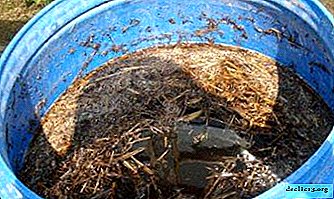 You will need:
You will need:- barrel;
- cow manure and water in a ratio of 1 to 3;
- superphosphate;
- potassium;
- nitrogen per 15 grams per 10 liters.
- Mix everything thoroughly in a barrel, leave to ferment for 14-17 days.
- Dilute the finished concentrate with water at the rate of 10 parts of water to 1 part of the mixture.
- In winter, fertilize with potassium solutions to increase frost resistance.
Pruning
It is produced in an extremely gentle manner. It is better to cut off only diseased shoots and very spruce twigs.
Transfer
Once again, changing the location of the plant is not required. But if for some reason a transplant is needed, it is recommended to do it in the early spring or autumn and adhere to such an algorithm:
- Choose a new location similar in parameters and conditions. A sharp change in conditions can adversely affect the health of the flower.
- Dig a rose with the largest possible clod of earth.
- Carefully wrap a lump of earth with roots in a cloth and transfer to a new place.
- Pour the prepared hole for planting with water in advance.
- After the water is absorbed, place the lump with roots in the pit, carefully fill it with soil and pour over water again.
- Water regularly and moderately, protect from direct sunlight.
Preparation for winter
Apply potash in September. The Midsammer is considered a winter-hardy variety, but if the winter in the region is still very harsh, at the base it is 35-40 centimeters. Then cover with a layer of sawdust, peat, spruce branches.
Step-by-step instruction: how to propagate?
The seed propagation method is described above, but it is still rarely used. Most often, this variety is propagated by cuttings:
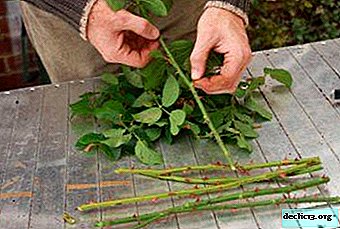 Shoot preparation. Cutting off the shoots is best in late July.
Shoot preparation. Cutting off the shoots is best in late July.- Cut a healthy shoot 45-50 cm long. The lower cut is oblique and 1 cm above the bottom sheet. The upper section is straight, 0.5 cm from the upper kidney. Next, pruning pruners with a pruner.
- Divide into the desired number of parts so that each part has at least 3 kidneys.
- Hold in a solution of manganese for 15-20 minutes, this will help prevent decay in the future.
There are many ways to stimulate root growth.
Next, we describe the Burrito method:
- Treat the ends of the shoots with any growth stimulating agent.
- Wrap the shoots in a wet newspaper, then place in a plastic bag and refrigerate for 20 days.
- Next, check for the formation of roots and if any, then you can safely transplant the shoot into the ground, to a permanent habitat.
Diseases and pests in relation to this species
The variety is resistant to most flower diseases. However, with improper care, some ailments can happen to her. Excessive watering causes root decay.. Lack of nutrition in the soil, sun and heat lead to sparse flowering.
Spider mites, scale insects and aphids - these are the pests that most often encroach on the Midsammer rose. The control of these pests is carried out by special insecticidal drugs. Very rarely, this rose is affected by fungal diseases, such as, for example, rust. The fight against the disease is as follows: treat the plant with fungicide.
Also the rose rarely gets bacterial cancer. It can be identified by dark spots on the stem. The fight against this ailment: treat Bordeaux mixture or copper sulphate.
We met an incredibly beautiful flower, the Midsammer rose. This is an unpretentious plant relative to other varieties, which, among other things, will please the gardener with chic flowering and a subtle, but pleasant aroma, uncharacteristic of other floribundas.

 Poor planting material. In this case, nothing can be done with the existing plant, but for the future it is worth taking shoots only in trusted nurseries.
Poor planting material. In this case, nothing can be done with the existing plant, but for the future it is worth taking shoots only in trusted nurseries. After a box with seeds is formed and ripens (after flowering), carefully open it and collect the seeds.
After a box with seeds is formed and ripens (after flowering), carefully open it and collect the seeds. You will need:
You will need: Shoot preparation. Cutting off the shoots is best in late July.
Shoot preparation. Cutting off the shoots is best in late July.